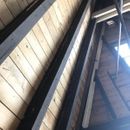Cellulose Insulation for a Cathedral Ceiling
Hi there! I’ve read a couple of articles and discussions on this site related to insulating cathedral ceilings and installing cellulose insulation. I still have a couple of questions.
My partner and I have a 70s-built A-frame with cathedral ceilings. The walls currently have no insulation (it was previously used as a summer house), so the roof sheathing is visible from the inside (see photo). We were initially going to get spray foam, but it’s beyond our budget so now we are weighing our options for a vented system. As for climate, we live in Atlantic Canada.
Here’s what I have in mind: install a ventilation baffle (that can withstand pressure from blown cellulose) against the sheathing, then cellulose, then rigid foam board (to create a barrier between the rafters and the interior wall), then a vapor barrier, then drywall over top. The depth of the rafters means that there’s only enough room to do about 4.5″ of cellulose over the baffle, plus the rigid foam board. The baffles would vent into an attic space at the peak of the building, which would also have cellulose blown on the floor.
– First off, is there anything problematic about this assembly?
– Is having a vapor barrier only on the interior side enough, or does it need to enclose all of the cellulose? I ask because, in Martin’s cathedral ceiling article, he states “If you are installing air-permeable insulation like fiberglass, mineral wool, or cellulose, the ventilation baffle isn’t optional; it’s required. Air-permeable insulation materials need to be enclosed by an air barrier on all six sides.”
– Should the baffles be sealed off as much as possible to prevent air from traveling from the cellulose to the ventilation cavity?
– Would dense-packed cellulose (3.5 lbs/cuft) be the preferred installation method over loose-fill for this type of vented assembly?
– Is dense-packed cellulose possible to DIY with a rented machine? If so, what’s the best way to achieve the proper density?
– Would anyone recommend a different type of insulation over cellulose for this set-up, such as rockwool?
Thanks in advance!
GBA Detail Library
A collection of one thousand construction details organized by climate and house part










Replies
A fair bit of the charm of A frame construction comes from the T&G ceiling and exposed beams. I would be hesitant to cover it all up.
Since A frames are a very simple shape, maybe consider an exterior insulation option. You can go with 3" to 5" of exterior polyiso over the existing roof and covered with metal roof panels. Because of the steep slope you can save a bit of cost and go for budget exposed fastener type panel.
This would cost a bit more, be less work overall than what you are proposing and keep the nice interior.
And be much less prone to possible moisture problems.
Hey! Thanks for the feedback. We aren't concerned with covering up the appearance of the rafter beams and the visible sheathing inside. I just want to make sure that the layers I'm proposing in the insulation assembly make sense and wouldn't cause any moisture problems.
As an assembly, there is nothing wrong with it. You can simply it a bit by using faced rigid and taping the seams which would work both as your air and vapor barrier.
Make sure to figure out how to get seal around your collar ties. This is a very hard intersection to get air tight. About the only thing that I've found that works is properly sized backer rod covered with flex caulk, even that is hard to get reliable. If the ceiling stops under the collar ties and the ties are in the attic than it is not an issue.
You can get semi dense pack with the box store machine but it is a very slow process, with tall walls like that there will always be some settling down the road. Try to overfill the attic area above the walls so that any settling in the walls can be taken up from the attic area. You'll need to make a reducer to get the pressure up. I used a set of exhaust tail pipe reducers from CT to go from the large hose down to 1.5". Make sure the reducer is gradual otherwise it will clog (I think I used 2 or 3 reducers). Even then, your helper will need to feed material in slowly to avoid clogging.
Besides needing to contain cellulose there is no need to air seal your baffles. Wind washing is mostly an issue with loose fill fiberglass, with anything higher density (cellulose, HD fiberglass or mineral wool) it doesn't change the R value much. In a vented roof your baffles should be somewhat permeable, use house wrap, thin OSB, fiberboard or unfaced rigid insulation.
These tips are really helpful, thank you very much. In this case, the collar ties will be inside the attic space so sealing around them won't be an issue.
Hello again! Just wondering, do you think hardboard would be a suitable material for the ventilation baffle? Thanks!
Hardboard will work. You have to watch with thinner board as it can bow a lot if you are dense packing. 1/2" MDF or fiberboard sheathing is a better bet, even that will bow.
You can also use high density fiberglass batts or mineral wool for the rafters and skip any baffles. You have to take a bit of care when installing not to push it in too far and block the vent space but that is about it. This is what I normally do for this type of vented roof.